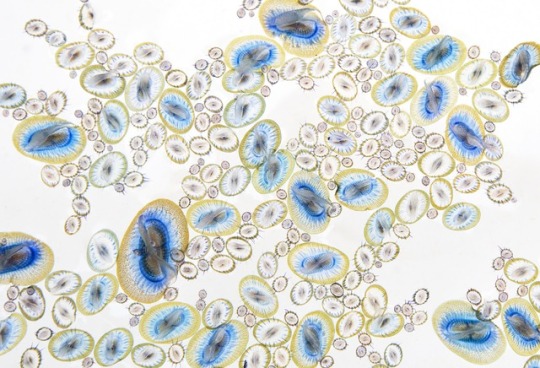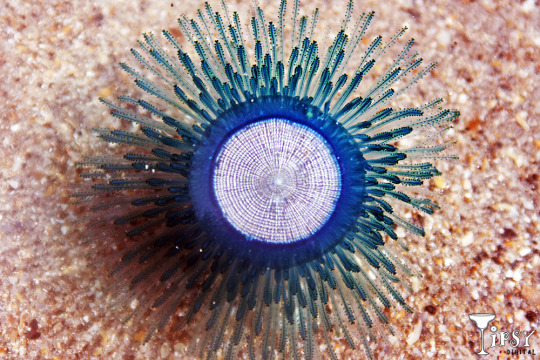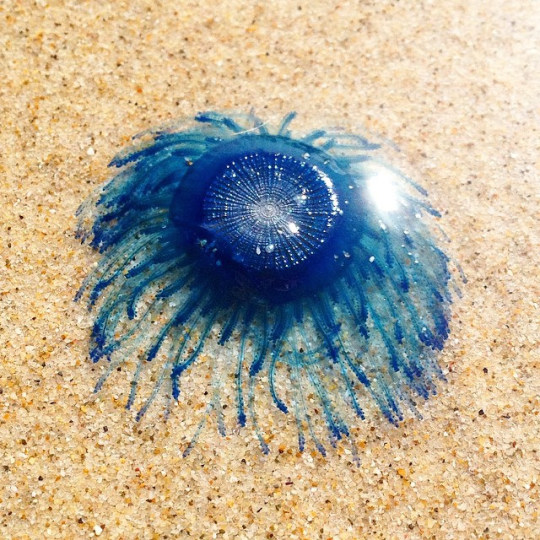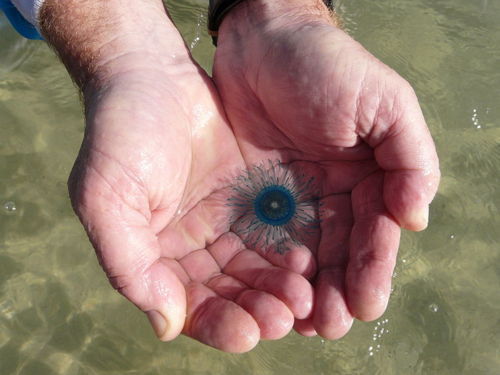#Porpitidae
Text

A crowd of sea rafts, or by-the-wind-sailors (Velella velella) in Morro Bay, California, USA
by Gregory "Slobirdr" Smith
#sea raft#by the wind sailor#hydrozoans#cnidarians#velella velella#velella#Porpitidae#Anthoathecata#hydrozoa#cnidaria#wildlife: california#wildlife: usa#wildlife: north america
49 notes
·
View notes
Text





Velella is a monospecific genus of hydrozoa in the Porpitidae family. Its only known species is Velella velella, a cosmopolitan free-floating hydrozoan that lives on the surface of the open ocean. It is commonly known by the names sea raft, by-the-wind sailor, purple sail, little sail, or simply Velella.
#velella#by the wind sailor#jellyfish#hydrozoa#marine biology#sea creatures#exotic sea creatures#porpitidae#sea raft#blue#see through creatures#marine life#see through#strange animals#ocean creatures#cool animals#hydrozoan#biology#marine animals#ocean animals#ocean life#sea#cool sea creatures#upload#fav#fav sea creatures#velella velella#little sail#purple sail#fav animals
318 notes
·
View notes
Photo

Dozens of by-the-wind sailors (Velella is a monospecific genus of hydrozoa in the Porpitidae family), measuring up to three inches long, viewed in a bucket of water at the Monteray Bay National Marine Sanctuary, California.
Each apparent individual is a hydroid colony, and most are less than about 7 cm long. They are usually deep blue in colour, but their most obvious feature is a small stiff sail that catches the wind and propels them over the surface of the sea.
Photograph: Jodi Frediani
45 notes
·
View notes
Text
Report on Cnidarians from Pulicat Lagoon- Juniper Publishers
Abstract
During our routine ecological survey conducted at Pulicat lagoon, the most diverse coelenterate belonging to 2 classes of scyphozoa (Catostylus mosaicus, Acromitus flagellates, Cyanea capillata, Chrysaora hysoscella) and hydrozoa (Porpita porpita) 4 families (Catostylidae, Cyaneidae, Pelagiidae and Porpitidae) and 5 species were recorded. The Catostylus mosaicus was dominated at the Barmouth. A large amount of species occurred during the monsoon season 2013 to 2015. Cnidarians were washed ashore. During the study, the salinity levels were maximum value observed was 41 while the minimum value obtained was 38ppt. Hence, it is necessary to focus on conservation, monitoring and management strategies in places of Pulicat lagoon.
Keywords: Jelly fish; Pulicat lagoon; Distribution
Introduction
Jelly fishes (Cnidaria), are well known bioindicators [1]. The increasing frequency of jelly fish outbreak events occurrence in marine and estuarine regions [2,3] suggested that rise in jellyfish abundance is just an up-phase of oscillations which occurred due to various factors. Worldwide Cnidaria 10,211 species and 752 species in the Mediterranean Sea, inhabiting entirely aquatic and mostly marine environments has reported [4,5]. In worldwide cnidarian class of Hydrozoa 3,643 species and Scyphozoa 228 species has reported [6]. Cnidarians species in Indian waters totally 842+, consisting of 212 species of class Hydrozoans and 25 species of scyphozoans were reported [7]. The Catostylus mosaicus has a long-lived medusa and historically has been considered a highly dispersive zooplankter, yet it has a marked phylogeographic discontinuity [8].
Pulicat is a small seashore township which offers an invigorating and thrilling experience of expedition. It is the second leading brackish lagoon in India-covering a total area of 720sqkm of which 84% comes in Andhra Pradesh and 16% in Tamil Nadu. In the present study, were improved our knowledge about the jellyfish diversity and distribution of Pulicat Lagoon were improved with meticulous observations and recordings.
Materials and Methods
Sample collection
Jelly fishes were collected using a120|im plankton net and preserved in 5% formalin at five sampling stations, namely Barmouth, Kunankuppam, Light house kuppam, Sattankuppam and Jameelabad were selected at Pulicat lagoon. The samples were brought to the laboratory and identified using authentic manual. Water sampling was done during 2013- 2015 period.
Physico-chemical analysis
Surface water was collected from the lagoon and stored in Polyethylene Terephthalate bottles. The bottles were rinsed using the sampling water and the water was collected with minimal disturbances in and around the collection points. The collected samples were then labelled and transferred to our laboratory for further analysis. Standard methods given by American public health association were utilized to analyze the samples [9]. The lagoon water quality was assessed by characterizing physicochemical parameters like pH, Temperature, Total Dissolved Solids, Dissolved Oxygen, Salinity, Carbonate, Bicarbonate, Nitrites and Phosphates.
Statistical analysis
The Shannon-Wiener diversity index, Simpson's index and Margalef's richness index were calculated for estimating cnidarians diversity. The data were subjected to diversity indices analysis using PAST Software, Margalef index, Shannon Diversity Index "H", Simpson Diversity Index"D" and Pielou Evenness Index "J"
Result and Discussion
Diversity of the coelenterate from Pulicat lagoon includes 2 classes, 4 families, 3 orders and 5 species (Table 1). The abundance of C. mosaicus and other species less numbers were estimated by stratified random sampling within the survey areas (Figure 1). The family Cyaneidae of Cyanea capillata were observed at Barmouth, Kunankuppam and family of Pelagiidae Chrysaora hysoscella were observed at Barmouth (Figure 1). The C. mosaicus, Acromitus flagellates and Porpita porpita species were spotted during the monsoon season of 2013 and 2015 and Chrysaora hysoscella species was recorded in 2013 summer (Table 2). Also an unidentified jelly fish included by him and not reported due to non-availability of identification manuals (Figure 2). Margalef index was minimum 0 at Light house kuppam, Sattan kuppam and Jameelabad, a maximum of 0.962 was recorded in the Barmouth (Table 3). Margalef Diversity Index "Ma" has no limit value and it showed variation depending upon the number of species. Thus, it is used for comparison between the sites. The present observed value was 7.78 which was also at the lower limit of the scale. Simson index minimum of 0 at the station at Sattankuppam and maximum of 1.600 at the Kunankuppam were noticed (Table 3). Simpson index closer to1 indicated nearly satisfactory diversity status of the Pulicat lagoon. Shanon winner index was a minimum of 0 in Light house kuppam, Sattankuppam and Jameelabad and maximum of 0.900 at Barmouth (S1) (Table 3). Diversity indices of jelly fish communities showed that Shannon index value (H) was 0.50, which was not at all satisfactory as 'H' value above 3 indicates better balance and stable habitat condition. Pielou index 'J' showed that jellyfish species were found a minimum of 0 at the Light house kuppam Sattankuppam and Jameelabad and maximum of 0.819 at Barmouth (Table 3). Pielou index 'J' showed that jelly fish species reported in the studied area was almost evenly distributed because our calculated values were closer to 1. Catostylidae family is found along the entire eastern coast of Australia, from the Torres Strait in the north to Port Phillip in the south [10]. C. mosaicus is an inshore species, sometimes occurring in bays and estuaries in very large numbers [10] and tolerates a wide range of temperature (10-28 °C) and salinity (12-39ppt) [11]. A. flagellatus pointed with smooth to finely granulated surface (Figure 1). Mouth-arms with basal regions joined by membrane, tapering to blunt point. Their habitat is coastal, sometimes brackish waters too. Distribution is along West Indian Ocean to central Pacific Ocean [12].
(+) present, (-) absent.
C. capillata is one of the largest jellyfish in the world. It gains its common name from the characteristic mass of long, thin, hair-like tentacles found hanging from the underside of the bell-shaped body. The C. capillata has a global distribution [13] although it is mostly found in the northern hemisphere in the North Atlantic, North Pacific and North Sea. C. hysoscella has a saucer-shaped bell (Figure 1), with 32 semi-circular lobes around the fringe, each one with a brown spot [14]. The mouth, the only opening to the exterior, is located on the centre of the underside of the bell, and is surrounded by 4 arms. There are also 24 tentacles around the edge of the bell, grouped in threes. The colour of this jellyfish varies, with a variable level of brown pigment [14]. These species were commonly widespread. P. porpita (Figure 1) marks the presence of a disc in the middle region which helps. The organism to float in the water and is golden brown in colour measuring around 1.5 inches width. The mouth present below the float is to engulf prey along with water and its ingredients. The second part is known as hydroid colony which posses bright coloured tentacles. With the help of these tentacles and the float it moves along and across the water body One can observe and admire the blue buttons for their beautiful colour but better to avoid contact which causes skin irritation, above all it is one of the good suppliers of bioactive compounds from the sea. In India [15] has reported in the Saurashtra Coast of Gujarat. In Tamil Nadu [16] in the Adirampattinam Mangrove Region.
The average values of water quality parameters in the study lagoon were shown in (Figure 3). During the study, the DO levels observed were maximum value of 2.912mg/l while the minimum value obtained was 2.098mg/l. The gradual reduction of dissolved oxygen levels implies deteriorating quality of the lake waters and its increasing unsuitability for industrial and domestic usage. The bicarbonate minimum 32.48mg/l at Jameelabad and maximum 38.48mg/l at Barmouth. The high amounts of nitrates and phosphates in the water bodies indicate higher levels of eutrophication [17]. These nitrates and phosphates prove to be the key to excessive algal blooms in the water bodies, thus increasing the pollution levels. The major source of phosphates is traced back to detergents and soaps used for household cleaning, while the nitrates are found as a result of discharge of untreated domestic sewage water. The algal blooms can be observed at values starting from 0.03 mg/l of phosphates in the water [18]. In conclusion, as a holistic approach to understanding and maintaining jelly fish diversity and water quality in semi-enclosed marine waters, is essential to study the animals found within the marine in relation to the hydrodynamics of the waters [19-21]. A good understanding of these can help to improve the management of cnidarians, in relation to maintaining a healthy ecological balance.
To Know More About Journal of Oceanography Please Click on:
https://juniperpublishers.com/ofoaj/index.php
To Know More About Open Access Journals Publishers Please Click on: Juniper Publishers
0 notes
Text
+ Bryozoa
+ Polyzoa
+ Hydrozoa - freshwater jelly (Craspedacusta sowerbyi), freshwater polyps (Hydra), Obelia, Portuguese man o' war(Physalia physalis), chondrophores (Porpitidae), "air fern" (Sertularia argentea), and pink-hearted hydroids (Tubularia)
0 notes
Video
youtube
(via Velella velella barchetta di San Pietro idrozoi Porpitidae intotheblue.it)
http://www.intotheblue.it/2019/05/01/velella-velella/
0 notes
Text
💙Blue Button “Jellyfish”🌊

Blue button jellyfish can’t sting, but will cause skin irritation.
This is a blue button jellyfish, known by their scientific name of Porpita porpita. They are in kingdom Animalia, phylum Cnidaria, class Hydrozoa, order Anthoathecata, family Porpitidae, and genus Porpita.
They’re mostly found in warm waters off Europe and in the Gulf of Mexico and live floating on the surface of the water and occasionally wash onto shore. They eat plankton, specifically and usually zooplankton.

They’re an average of about one inch. Tiny little dudes!
Blue button jellyfish have both male and female reproductive organs. They release sperm and egg cells into the water to be fertilized by another blue button jelly’s sperm/egg cells. This creates a larvae that forms into individual polyps and eventually into a whole colony. Each polyp in a blue button jelly has its own purpose.
Though they are called blue button “jellyfish,” they aren’t actually jellies! They’re cnidarians, meaning they are radially symmetrical invertebrates often confused with organisms like jellyfish.

They get competitive with other drifters for their food.
They’re related to the Blue Bottle and Portuguese Man of War and definitely share a common ancestor, but its difficult for researchers to track exactly what this ancestor was like.
This video shows them IN ACTION! Though it isn’t actually that exciting, they just drift around, but it’s still cool!
0 notes
Text
<a href=http://www.biyolojisozluk.com/yelkenli-kralice-mor-yelkenli-velella-velella-porpitidae-animalia/>Yelkenli Kraliçe, Mor yelkenli, Velella velella, Porpitidae, Animalia</a> - At www.biyolojisozluk.com, the privacy of our visitors is of extreme importance to us (See this article to learn more about Privacy Policies.). This privacy policy document outlines the types of personal information is received and collected by www.biyolojisozluk.com and how it is used. Log...
Yelkenli Kraliçe, Mor yelkenli, Velella velella, Porpitidae, Animalia At www.biyolojisozluk.com, the privacy of our visitors is of extreme importance to us (See this article to learn more about Privacy Policies.). This privacy policy document outlines the types of personal information is received and collected by www.biyolojisozluk.com and how it is used. Log... Biyoloji Sözlük
0 notes
Text
Report on Cnidarians from Pulicat Lagoon- Juniper Publishers
Abstract
During our routine ecological survey conducted at Pulicat lagoon, the most diverse coelenterate belonging to 2 classes of scyphozoa (Catostylus mosaicus, Acromitus flagellates, Cyanea capillata, Chrysaora hysoscella) and hydrozoa (Porpita porpita) 4 families (Catostylidae, Cyaneidae, Pelagiidae and Porpitidae) and 5 species were recorded. The Catostylus mosaicus was dominated at the Barmouth. A large amount of species occurred during the monsoon season 2013 to 2015. Cnidarians were washed ashore. During the study, the salinity levels were maximum value observed was 41 while the minimum value obtained was 38ppt. Hence, it is necessary to focus on conservation, monitoring and management strategies in places of Pulicat lagoon.
Keywords: Jelly fish; Pulicat lagoon; Distribution
Introduction
Jelly fishes (Cnidaria), are well known bioindicators [1]. The increasing frequency of jelly fish outbreak events occurrence in marine and estuarine regions [2,3] suggested that rise in jellyfish abundance is just an up-phase of oscillations which occurred due to various factors. Worldwide Cnidaria 10,211 species and 752 species in the Mediterranean Sea, inhabiting entirely aquatic and mostly marine environments has reported [4,5]. In worldwide cnidarian class of Hydrozoa 3,643 species and Scyphozoa 228 species has reported [6]. Cnidarians species in Indian waters totally 842+, consisting of 212 species of class Hydrozoans and 25 species of scyphozoans were reported [7]. The Catostylus mosaicus has a long-lived medusa and historically has been considered a highly dispersive zooplankter, yet it has a marked phylogeographic discontinuity [8].
Pulicat is a small seashore township which offers an invigorating and thrilling experience of expedition. It is the second leading brackish lagoon in India-covering a total area of 720sqkm of which 84% comes in Andhra Pradesh and 16% in Tamil Nadu. In the present study, were improved our knowledge about the jellyfish diversity and distribution of Pulicat Lagoon were improved with meticulous observations and recordings.
Materials and Methods
Sample collection
Jelly fishes were collected using a120|im plankton net and preserved in 5% formalin at five sampling stations, namely Barmouth, Kunankuppam, Light house kuppam, Sattankuppam and Jameelabad were selected at Pulicat lagoon. The samples were brought to the laboratory and identified using authentic manual. Water sampling was done during 2013- 2015 period.
Physico-chemical analysis
Surface water was collected from the lagoon and stored in Polyethylene Terephthalate bottles. The bottles were rinsed using the sampling water and the water was collected with minimal disturbances in and around the collection points. The collected samples were then labelled and transferred to our laboratory for further analysis. Standard methods given by American public health association were utilized to analyze the samples [9]. The lagoon water quality was assessed by characterizing physicochemical parameters like pH, Temperature, Total Dissolved Solids, Dissolved Oxygen, Salinity, Carbonate, Bicarbonate, Nitrites and Phosphates.
Statistical analysis
The Shannon-Wiener diversity index, Simpson's index and Margalef's richness index were calculated for estimating cnidarians diversity. The data were subjected to diversity indices analysis using PAST Software, Margalef index, Shannon Diversity Index "H", Simpson Diversity Index"D" and Pielou Evenness Index "J"
Result and Discussion
Diversity of the coelenterate from Pulicat lagoon includes 2 classes, 4 families, 3 orders and 5 species (Table 1). The abundance of C. mosaicus and other species less numbers were estimated by stratified random sampling within the survey areas (Figure 1). The family Cyaneidae of Cyanea capillata were observed at Barmouth, Kunankuppam and family of Pelagiidae Chrysaora hysoscella were observed at Barmouth (Figure 1). The C. mosaicus, Acromitus flagellates and Porpita porpita species were spotted during the monsoon season of 2013 and 2015 and Chrysaora hysoscella species was recorded in 2013 summer (Table 2). Also an unidentified jelly fish included by him and not reported due to non-availability of identification manuals (Figure 2). Margalef index was minimum 0 at Light house kuppam, Sattan kuppam and Jameelabad, a maximum of 0.962 was recorded in the Barmouth (Table 3). Margalef Diversity Index "Ma" has no limit value and it showed variation depending upon the number of species. Thus, it is used for comparison between the sites. The present observed value was 7.78 which was also at the lower limit of the scale. Simson index minimum of 0 at the station at Sattankuppam and maximum of 1.600 at the Kunankuppam were noticed (Table 3). Simpson index closer to1 indicated nearly satisfactory diversity status of the Pulicat lagoon. Shanon winner index was a minimum of 0 in Light house kuppam, Sattankuppam and Jameelabad and maximum of 0.900 at Barmouth (S1) (Table 3). Diversity indices of jelly fish communities showed that Shannon index value (H) was 0.50, which was not at all satisfactory as 'H' value above 3 indicates better balance and stable habitat condition. Pielou index 'J' showed that jellyfish species were found a minimum of 0 at the Light house kuppam Sattankuppam and Jameelabad and maximum of 0.819 at Barmouth (Table 3). Pielou index 'J' showed that jelly fish species reported in the studied area was almost evenly distributed because our calculated values were closer to 1. Catostylidae family is found along the entire eastern coast of Australia, from the Torres Strait in the north to Port Phillip in the south [10]. C. mosaicus is an inshore species, sometimes occurring in bays and estuaries in very large numbers [10] and tolerates a wide range of temperature (10-28 °C) and salinity (12-39ppt) [11]. A. flagellatus pointed with smooth to finely granulated surface (Figure 1). Mouth-arms with basal regions joined by membrane, tapering to blunt point. Their habitat is coastal, sometimes brackish waters too. Distribution is along West Indian Ocean to central Pacific Ocean [12].
(+) present, (-) absent.
C. capillata is one of the largest jellyfish in the world. It gains its common name from the characteristic mass of long, thin, hair-like tentacles found hanging from the underside of the bell-shaped body. The C. capillata has a global distribution [13] although it is mostly found in the northern hemisphere in the North Atlantic, North Pacific and North Sea. C. hysoscella has a saucer-shaped bell (Figure 1), with 32 semi-circular lobes around the fringe, each one with a brown spot [14]. The mouth, the only opening to the exterior, is located on the centre of the underside of the bell, and is surrounded by 4 arms. There are also 24 tentacles around the edge of the bell, grouped in threes. The colour of this jellyfish varies, with a variable level of brown pigment [14]. These species were commonly widespread. P. porpita (Figure 1) marks the presence of a disc in the middle region which helps. The organism to float in the water and is golden brown in colour measuring around 1.5 inches width. The mouth present below the float is to engulf prey along with water and its ingredients. The second part is known as hydroid colony which posses bright coloured tentacles. With the help of these tentacles and the float it moves along and across the water body One can observe and admire the blue buttons for their beautiful colour but better to avoid contact which causes skin irritation, above all it is one of the good suppliers of bioactive compounds from the sea. In India [15] has reported in the Saurashtra Coast of Gujarat. In Tamil Nadu [16] in the Adirampattinam Mangrove Region.
The average values of water quality parameters in the study lagoon were shown in (Figure 3). During the study, the DO levels observed were maximum value of 2.912mg/l while the minimum value obtained was 2.098mg/l. The gradual reduction of dissolved oxygen levels implies deteriorating quality of the lake waters and its increasing unsuitability for industrial and domestic usage. The bicarbonate minimum 32.48mg/l at Jameelabad and maximum 38.48mg/l at Barmouth. The high amounts of nitrates and phosphates in the water bodies indicate higher levels of eutrophication [17]. These nitrates and phosphates prove to be the key to excessive algal blooms in the water bodies, thus increasing the pollution levels. The major source of phosphates is traced back to detergents and soaps used for household cleaning, while the nitrates are found as a result of discharge of untreated domestic sewage water. The algal blooms can be observed at values starting from 0.03 mg/l of phosphates in the water [18]. In conclusion, as a holistic approach to understanding and maintaining jelly fish diversity and water quality in semi-enclosed marine waters, is essential to study the animals found within the marine in relation to the hydrodynamics of the waters [19-21]. A good understanding of these can help to improve the management of cnidarians, in relation to maintaining a healthy ecological balance.
To Know More About Journal of Oceanography Please Click on: https://juniperpublishers.com/ofoaj/index.php
0 notes